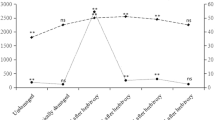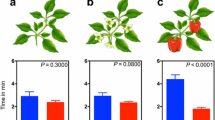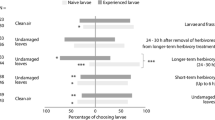Abstract
Plants respond to herbivory by synthesizing and releasing novel blends of volatile organic compounds (VOCs). Natural enemies are attracted to these VOCs, but little is known about the effects of these chemicals on the herbivores themselves. We studied the effect of Thaumastocoris peregrinus herbivory on VOCs released by Eucalyptus benthamii plants and the responses of this herbivore to the VOCs. In total, 12 compounds released by E. benthamii were identified. Five compounds (β-pinene, linalool, 9-epi-(E)-caryophyllene, viridiflorol, and one unidentified compound) emitted after herbivore and mechanical damage were not detected in collections from undamaged plants. The three most abundant VOCs, α-pinene, aromadendrene, and globulol, were released in greater quantities from herbivore-damaged plants compared to plants with mechanical damage, which, in turn, released greater amounts than undamaged (control) plants. The VOCs emitted after herbivore damage did not differ during the photophase and scotophase in either quantity or quality. In an olfactometer, mated female T. peregrinus showed a preference for undamaged plants over herbivore-damaged plants, and also for hexane over α-pinene at an amount equivalent to that released by a herbivore-damaged plant. In the olfactometer, virgin females did not exhibit any preference between conspecific-damaged or undamaged plants.








Similar content being viewed by others
References
Adams, R. P. 2007. Identification of Essential Oil Components by Gas Chromatography/Mass Spectrometry, 4th Edition. Allured Publishing Corporation, 804 pp.
Ayres, M., Ayres JR. M., and Santos, A. S. 2003. Bioestat 3.0. Soc. Civil Mamirauá, Belém.
BATISH, D. R., SINGH, H. P., KOHLI, R. K., and KAUR, S. 2008. Eucalyptus essential oil as a natural pesticide. Forest Ecol. Manag. 256:2166–2174.
Bouwer, M. C. 2010. Identification of volatile organic compounds from Eucalyptus detected by Gonipterus scutellatus (Gyllenhal) females. MSc dissertation. University of Pretoria, Pretoria.
Delphia, C. M., Mescher, M. C., and de Moraes, C. M. 2007. Induction of Plant Volatiles by Herbivores with Different Feeding Habits and the Effects of Induced Defenses on Host-Plant Selection by Thrips. J. Chem. Ecol. 33:997–1012.
de Moraes, C. M., Mescher, M. C., and Tumlinson, J. H. 2001. Caterpillar-induced nocturnal plant volatiles repel conspecific females. Nature. 410:577–580.
de Moraes, C. M., Lewis, W. J., and PARE, P. W. 1998. Herbivore-infested plants selectively attract parasitoids. Nature. 393:570–573.
Dicke, M. and van Loon, J. J. A. 2000. Multitrophic effects of herbivore-induced plant volatiles in an evolutionary context. Entomol. Exp. Appl. 97:237–249.
Döll-Boscardin, P. M., Farago, P. V., Nakashima, T., dos Santos, P. E. T., and de Paula, J. F. P. 2010. Estudo Anatômico e Prospecção Fitoquímica de Folhas de Eucalyptus benthamii Maiden et Cambage. Lat. Am. J. Pharm. 29:94–101.
He, C., Murray, F., and Lyons, T. 2000. Monoterpene and isoprene emissions from 15 Eucalyptus species in Australia. Atmos. Environ. 34:645–655.
Hegde, M., Oliveira, J. N., da Costa, J. G., Bleicher, E., Santana, A. E. G., Bruce, T. J. A., Caulfield, J., Dewhirst, S. Y., Woodcock, C. M., Pickett, J. A., and Birkett, M. A. 2011. Identification of Semiochemicals Released by Cotton, Gossypium hirsutum, Upon Infestation by the Cotton Aphid, Aphis gossypii. J. Chem. Ecol. 37:741–750.
Kesselmeier, J. and Staudt, M. 1999. Biogenic Volatile Organic Compounds (VOC): An Overview on Emission, Physiology and Ecology. J. Atmos. Chem. 33:23–88.
Kugimiya, S., Shimoda, T., Wajnberg, E., Uefune, M., and Takabayashi, J. 2010. Host-searching responses to herbivory-associated chemical information and patch use depend on mating status of female solitary parasitoid wasps. Ecol. Entomol. 35:279–286.
LIU, Z. L., YU, M., and LI, X. A. M. 2011. Repellent activity of eight essential oils of Chinese Medicinal Herbs to Blatella germanica. Rec. Nat. Prod. 5:176–183.
Loughrin, J. H., Manukian, A., Heath, R. R., and Tumlinson, J. H. 1994. Diurnal cycle of emission of induced volatile terpenoids by herbivore-injured cotton plants. P Natl Acad Sci USA 21:1217–1227.
Matsui, K. 2006. Green leaf volatiles: Hydroperoxide lyase pathway of oxylipin metabolism. Cur. Opin. Plant Bio. 9:274–280.
NADEL, R. L. and SLIPPERS, B. 2009. DNA bar-coding reveals source and patterns of Thaumastocoris peregrinus invasions in South Africa and South America. Invasions. 12:1067–1077.
Piesik, D., Wenda-Piesik, A., Kotwica, K., Tyszcarz, A., and Delaney, K. J. 2011. Gastrophysa polygoni herbivory on Rumex confertus: Single leaf VOC induction and dose dependent herbivore attraction/repellence to individual compounds. J. Plant Physiol. 168:2134–2138.
Proffit, M., Birgersson, G., Bengtsson, M., REIS Jr., R., Witzgall, P., and LIMA, E. 2011. Attraction and Oviposition of Tuta absoluta Females in Response to Tomato Leaf Volatiles. J. Chem. Ecol. 37:565–574.
R Development Core Team. 2011. R: a language and environment for statistical 584 computing. http://www.R-project.org.
Romeis, J., Ebbinghaus, D., and Scherkenbeck, J. 2003. Factors accounting for the variability in the behavioral response of the onion fly (Delia antiqua) to n-dipropyl disulfide. J. Chem. Ecol. 29:2131–2142.
Schültz, S., WEIßBECKER, B., KLEIN, A., and HUMMEL, H. E. 1997. Host plant selection of the Colorado Potato Beetle as influenced by damage induced volatiles of the potato plant. Naturwissenschaften 84:212–217.
Smith, B. 1999. Infrared Spectral Interpretation: A Systematic Approach. CRC Press, 265 pp.
STAUDT, M., BERTIN, N., HANSEN, U., SEUFERT, G., CICCIOLI, P., FOSTER, P., FRENZEL, B., and FUGIT, J.-L. 1997. Seasonal and diurnal patterns of monoterpene emissions from Pinus pinea (L.) under field conditions. Atmos. Environ. 31:145–156.
Su, Y. U.-C. H. A. N. G, Ho, C. H. E. N.-L. U. N. G., Wang, E. I.-C. H. E. N, and Chang, S. H. A. N. G.-T. S. E. N. 2006. Antifungal Activities and Chemical Compositions of Essential Oils from Leaves of Four Eucalypts. Taiwan J. For. Sci. 21:49–61.
Thaler, J. S. 1999. Jasmonate-inducible plant defenses cause increased parasitism of herbivores. Nature. 399:686–588.
Turlings, T. C. J., Tumlinson, J. H., and Lewis, W. J. 1990. Exploitation of herbivore-induced plant odors by host-seeking parasitic wasps. Science. 250:1251–1253.
Turlings, T. C. J. and Wäckers, F. 2004. Recruitment of predators and parasitoids by herbivore-injured plants, pp. 21–75, in R. T. Cardé and J. G. Millar (eds.), Advances in Insect Chemical Ecology. Cambridge University Press, Cambridge.
Walling, L. L. 2000. The myriad plant responses to herbivores. J. Plant Growth Regul. 19:195–216.
Wilcken, C., Soliman, E., Soliman, E. P., Sá, L. A. N., Barbosa, L. R., Dias, T. K. R., Ferreira-Filho, P. J., and Oliveira, R. J. R. 2010. Bronze bug Thaumastocoris peregrinus Carpintero and Dellapé (Hemiptera: Thaumastocoridae) on Eucalyptus in Brazil and its distribution. J. Plant Protection Res. 50:201–205.
Winters, A. J., Adams, M. A., Bleby, T. M., Rennenberg, H., Steigner, D., STEINBRECHER, and Kreuzwieser, R. J. 2009. Emissions of isoprene, monoterpene and short-chained carbonyl compounds from Eucalyptus spp. in southern Australia. Atmos. Environ. 43:3035–3043.
Zarbin, P. H. G., Ferreira, J. T. B., and Leal, W. S. 1999. Metodologias gerais empregadas no isolamento e identificação estrutural de feromônio de insetos. Química Nova 22:263–268.
Zini, C. A., Augusto, F., Christensen, E., Carama, E. B., and Pawliszyn, J. 2002. SPME Applied to the Study of Volatile Organic Compounds Emitted by Three Species of Eucalyptus in Situ. J. Agric. Food Chem. 50:7199–7205.
Acknowledgments
The authors thank Dr. Delia Pinto for the improvement of the manuscript, Dr. Leonardo Rodrigues Barbosa from the Embrapa Florestas—CNPF Colombo/PR for the insects and plants, Dr. Maurício Osvaldo Moura for the statistical analyses, the Conselho Nacional de Desenvolvimento Científico e Tecnológico (CNPq) and the Semioquímicos na Agricultura (INCT) - for the financial support.
Author information
Authors and Affiliations
Corresponding author
Rights and permissions
About this article
Cite this article
Martins, C.B.C., Zarbin, P.H.G. Volatile Organic Compounds of Conspecific-Damaged Eucalyptus benthamii Influence Responses of Mated Females of Thaumastocoris peregrinus . J Chem Ecol 39, 602–611 (2013). https://doi.org/10.1007/s10886-013-0287-y
Received:
Revised:
Accepted:
Published:
Issue Date:
DOI: https://doi.org/10.1007/s10886-013-0287-y




